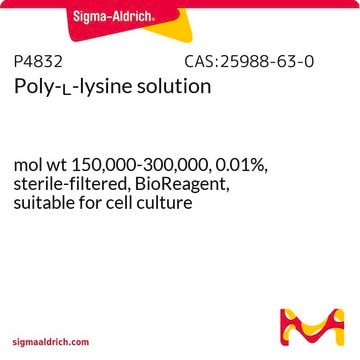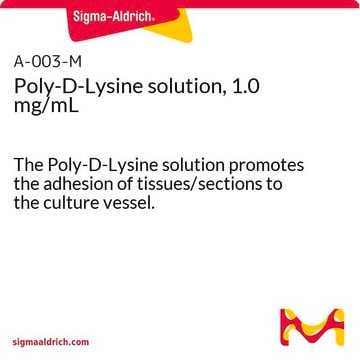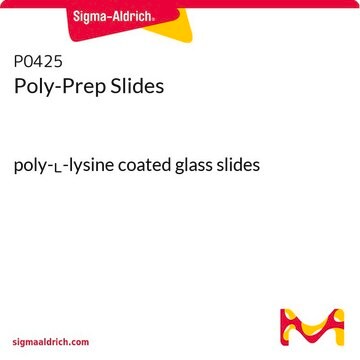The product is provided as a 0.01% sterile filtered solution in water. When coating slides with this solution, it is recommended to incubate for 5 minutes and allow the slides to dry at room temperature.
P4707
Poly-ʟ-Lysine Hydrobromide
synthetic, liquid, 0.01%, suitable for cell culture
Synonym(s):
PLL Solution
About This Item
Recommended Products
Product Name
Poly-L-lysine solution, 0.01%, sterile-filtered, BioReagent, suitable for cell culture
biological source
synthetic
Quality Level
sterility
sterile-filtered
product line
BioReagent
form
liquid
mol wt
70—150 kDa
packaging
pkg of 50 mL
concentration
0.01%
technique(s)
cell culture | mammalian: suitable
surface coverage
4 μg/cm2
impurities
endotoxin, tested
solubility
water: soluble
shipped in
ambient
storage temp.
2-8°C
SMILES string
N([C@@H](CCCCN)C(=O)N[C@@H](CCCCN)C(=O)O)C(=O)[C@@H](N)CCCCN
InChI
1S/C18H38N6O4/c19-10-4-1-7-13(22)16(25)23-14(8-2-5-11-20)17(26)24-15(18(27)28)9-3-6-12-21/h13-15H,1-12,19-22H2,(H,23,25)(H,24,26)(H,27,28)/t13-,14-,15-/m0/s1
InChI key
WBSCNDJQPKSPII-KKUMJFAQSA-N
Looking for similar products? Visit Product Comparison Guide
General description
Application
- Poly-L-lysine coated glass coverslips have been used for mounting samples for scanning electron microscopy.[1]
- Poly-L-lysine coated wells were used for trapping of PC-12 cells on electrodes.[2]
- Poly-L-lysine-coated borosilicate glass slides were used for the seeding of viral vector-transduced cells.[3]
Biochem/physiol Actions
Components
Preparation Note
comparable product
related product
Storage Class Code
12 - Non Combustible Liquids
WGK
WGK 2
Flash Point(F)
Not applicable
Flash Point(C)
Not applicable
Choose from one of the most recent versions:
Already Own This Product?
Find documentation for the products that you have recently purchased in the Document Library.
Customers Also Viewed
Articles
Poly-Lysine enhances cell binding with positively-charged surface ions, optimizing electrostatic interaction on culture surfaces for increased cell attachment.
Poly-Lysine enhances cell binding with positively-charged surface ions, optimizing electrostatic interaction on culture surfaces for increased cell attachment.
Poly-Lysine enhances cell binding with positively-charged surface ions, optimizing electrostatic interaction on culture surfaces for increased cell attachment.
Poly-Lysine enhances cell binding with positively-charged surface ions, optimizing electrostatic interaction on culture surfaces for increased cell attachment.
Protocols
Adhere cells to solid substrates using poly-lysine, which enhances electrostatic interaction between negatively charged ions of the cell membrane and the culture surface.
-
When coating coverslips with item P4707, is it necessary to wash the reagent off after 5 minutes, or is there a different recommended procedure?
1 answer-
Helpful?
-
-
Is the product P4707 suitable for coating glassware for cell culture? Also, what is the difference between Poly L and Poly D lysine?
1 answer-
Yes, the product P4707 is suitable for coating glassware for cell culture. The difference between Poly L and Poly D lysine lies in their stereoisomeric properties. Poly-L-Lysine is a charge enhancer and can be used for coating many surfaces, including tissue culture plasticware and glassware. However, certain cells can digest poly-L-lysine, in which case the poly-D-lysine, such as P7405, should be used. This product can also be used to coat tissue culture plasticware and glassware.
Helpful?
-
-
How many times can it be reused?
1 answer-
The number of times that this product may be re-applied has not been determined. This would be dependent on several factors, such as surface area, material type, surface pretreatment, and incubation period. Please see the link below to review the product datasheet for additional information:
https://www.sigmaaldrich.com/deepweb/assets/sigmaaldrich/product/documents/244/731/p4707pis.pdfHelpful?
-
-
What is the molecular weight of product P4707?
1 answer-
Poly-L-lysine solution is 70-150 kDa molecular weight.
Helpful?
-
-
Should I use Poly-L-Lysine or Poly-D-Lysine?
1 answer-
Certain cells secrete proteases, which can digest poly-L-lysine. For those cell types, poly-D-lysine should be used.
Helpful?
-
-
How should I dilute Product P4707, Poly-L-Lysine solution?
1 answer-
For coating slides with poly-L-lysine, in general, it is recommended to use a 0.01% (w/v) solution. However, if your protocol requires a more dilute solution, you can add sterile water or sterile buffer like Phosphate Buffered Saline.
Helpful?
-
-
What is the concentration of Product P4707, Poly-L-Lysine solution?
1 answer-
This product is supplied as a 0.01% w/v solution.
Helpful?
-
-
What is the protocol for using Product P4707, Poly-L-Lysine solution, to coat tissue culture plasticware?
1 answer-
A solution of 0.1 mg/mL is prepared; 0.5 mL of that solution is aseptically transferred to a non-tissue culture treated 25 square cm flask. The flask is gently rocked to evenly coat the surface. After five minutes, the excess solution is removed and the surface is thoroughly rinsed with sterile water and allowed to dry for several hours.
Helpful?
-
-
What molecular weight Poly-L-Lysine product should I choose?
1 answer-
The lower molecular weight poly-L-lysine (30-70 kDa) is easier to use because it is less viscous in solution, but the higher molecular weight poly-L-lysine (>300 kDa) provides more attachment sites per molecule. The mid-range product has a molecular weight range of 70-150 kDa.
Helpful?
-
-
What is the protocol for using Product P4707, Poly-L-Lysine solution, to coat slides?
1 answer-
For coating slides with poly-L-lysine, in general, it is recommended to use a 0.01% (w/v) solution. After a 5 minute incubation, the excess solution is removed and the slides are dried at room temperature or in an oven at gentle heat.
Helpful?
-
Active Filters
Our team of scientists has experience in all areas of research including Life Science, Material Science, Chemical Synthesis, Chromatography, Analytical and many others.
Contact Technical Service








